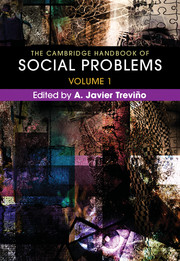Book contents
- The Cambridge Handbook of Social Problems
- The Cambridge Handbook of Social Problems
- Copyright page
- Contents
- About the Contributors
- Introduction
- Part I General Concerns and Orientations in the Study of Social Problems
- Chapter 1 The Challenges of Conceptualizing Social Problems
- Chapter 2 Research Methods
- Chapter 3 Participatory Action Research and Social Problems
- Chapter 4 Public Policy and Social Problems: Recent Trends in the Formal Control of Individual Behavior
- Chapter 5 Social Problems in Global Perspective
- Chapter 6 Bridging Social Movements and Social Problems
- Chapter 7 Public Sociology and Social Problems
- Chapter 8 Service Sociology and Social Problems*
- Chapter 9 Astrosociology: Social Problems on Earth and in Outer Space
- Chapter 10 Prospects for the Sociological Study of Social Problems*
- Part II Historical and Theoretical Issues in the Study of Social Problems
- Part III Problems of Discrimination and Inequality
- Part IV Problems of Institutions
- Index
- References
Chapter 4 - Public Policy and Social Problems: Recent Trends in the Formal Control of Individual Behavior
from Part I - General Concerns and Orientations in the Study of Social Problems
Published online by Cambridge University Press: 16 March 2018
- The Cambridge Handbook of Social Problems
- The Cambridge Handbook of Social Problems
- Copyright page
- Contents
- About the Contributors
- Introduction
- Part I General Concerns and Orientations in the Study of Social Problems
- Chapter 1 The Challenges of Conceptualizing Social Problems
- Chapter 2 Research Methods
- Chapter 3 Participatory Action Research and Social Problems
- Chapter 4 Public Policy and Social Problems: Recent Trends in the Formal Control of Individual Behavior
- Chapter 5 Social Problems in Global Perspective
- Chapter 6 Bridging Social Movements and Social Problems
- Chapter 7 Public Sociology and Social Problems
- Chapter 8 Service Sociology and Social Problems*
- Chapter 9 Astrosociology: Social Problems on Earth and in Outer Space
- Chapter 10 Prospects for the Sociological Study of Social Problems*
- Part II Historical and Theoretical Issues in the Study of Social Problems
- Part III Problems of Discrimination and Inequality
- Part IV Problems of Institutions
- Index
- References
Summary
This chapter describes the development of public policy regarding the control of individual behavior in the criminal justice system, or alternative programs outside the criminal justice system. We focus on developments in the United States, primarily in the late twentieth century and later. We identify instances of both expansion/escalation and contraction/deescalation of control and indicate how the latter may be a consequence of and partial solution to the human and economic burdens of the former. We also examine the diffusion of philosophies and practices between institutional sectors of social control (criminal justice, mental health, education) and the shifting of responsibility for control between state and local government, again in response to the human and economic burdens of the preexisting control strategies. Finally, we offer reflections on possible future developments of the trends we have identified.
- Type
- Chapter
- Information
- The Cambridge Handbook of Social Problems , pp. 57 - 76Publisher: Cambridge University PressPrint publication year: 2018



